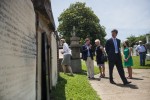 Timothy Shriver, son of Robert Sargent Shriver Jr. and Eunice Kennedy Shriver, brother of journalist and former California First Lady Maria Shriver, attended a memorial service Wednesday for relatives he didn’t know he had. They were prominent people in their day, but over time their final resting place in Washington, D.C.’s Congressional Cemetery had fallen into disrepair and was in dire need of restoration. Since the brick vault could not be repaired while the remains were still inside, in 2009 Douglas Owsley, head of the Natural History museum’s Physical Anthropology Department, was asked to excavate it and identify the remains for future reburial. After years of research and restoration, the skeletal remains of 16 people were reinterred in the tomb attended by a small group of Shriver relatives.
Timothy Shriver, son of Robert Sargent Shriver Jr. and Eunice Kennedy Shriver, brother of journalist and former California First Lady Maria Shriver, attended a memorial service Wednesday for relatives he didn’t know he had. They were prominent people in their day, but over time their final resting place in Washington, D.C.’s Congressional Cemetery had fallen into disrepair and was in dire need of restoration. Since the brick vault could not be repaired while the remains were still inside, in 2009 Douglas Owsley, head of the Natural History museum’s Physical Anthropology Department, was asked to excavate it and identify the remains for future reburial. After years of research and restoration, the skeletal remains of 16 people were reinterred in the tomb attended by a small group of Shriver relatives.
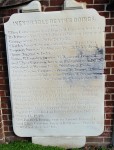 The Causten Vault was built in 1835 by lawyer and international diplomat James H. Causten after the tragic death of his first son, Charles Isaac, who passed away just days short of his second birthday. According to his obituary, little Charles “was a child of uncommon intelligence and excited the admiration and affectionate regard of all that knew him. His family have much cause to regret the early fall of one so interesting and promising.”
The Causten Vault was built in 1835 by lawyer and international diplomat James H. Causten after the tragic death of his first son, Charles Isaac, who passed away just days short of his second birthday. According to his obituary, little Charles “was a child of uncommon intelligence and excited the admiration and affectionate regard of all that knew him. His family have much cause to regret the early fall of one so interesting and promising.”
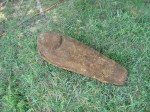 James Causten would outlive all but one of his children, and his daughter Josephine only outlived him by four years. His eldest daughter Henrietta Jane was the Shriver connection. She married Joseph Shriver, scion of an important Baltimore family that included a signer of the 1776 Maryland Constitution. Henrietta died in 1863 of a sudden heart attack when she was 52, “leaving both families overwhelmed in grief at this loss of their richest jewels.” She was buried in the vault, joining her daughter Josephine Shriver who had died 14 years before her mother at the age of four.
James Causten would outlive all but one of his children, and his daughter Josephine only outlived him by four years. His eldest daughter Henrietta Jane was the Shriver connection. She married Joseph Shriver, scion of an important Baltimore family that included a signer of the 1776 Maryland Constitution. Henrietta died in 1863 of a sudden heart attack when she was 52, “leaving both families overwhelmed in grief at this loss of their richest jewels.” She was buried in the vault, joining her daughter Josephine Shriver who had died 14 years before her mother at the age of four.
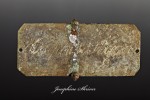 After his death in 1874 at the age of 86, Causten was buried in the family vault, which was already so sadly well-populated by then. It would eventually hold the remains of 22 members of the extended family, and that’s not counting the eight temporary residents who were placed in the vault while arrangements were made for permanent burials elsewhere. One of them was First Lady Dolley Madison. Her niece and adopted daughter was Annie Payne Causten, wife of Dr. James H. Causten Jr., the founder’s son. After Dolley died in July of 1849, she was buried in the Public Vault of the Congressional Cemetery ostensibly just until arrangements could be made to bury her by her husband’s side at his Virginia estate Montpelier. Unfortunately her gambling, alcoholic wastrel son, whose endless debts were a major reason for her poverty in old age, set aside no money for her burial. When he died of typhoid fever less than three years after his mother, she was still in the Public Vault. A month later, Annie Payne Causten had Dolley’s remains moved to the Causten Vault. Unfortunately she died a few months later aged just 33, so Dolley’s remains stayed in the vault for another six years. Finally the Caustens saw to it that she was buried in Montpelier.
After his death in 1874 at the age of 86, Causten was buried in the family vault, which was already so sadly well-populated by then. It would eventually hold the remains of 22 members of the extended family, and that’s not counting the eight temporary residents who were placed in the vault while arrangements were made for permanent burials elsewhere. One of them was First Lady Dolley Madison. Her niece and adopted daughter was Annie Payne Causten, wife of Dr. James H. Causten Jr., the founder’s son. After Dolley died in July of 1849, she was buried in the Public Vault of the Congressional Cemetery ostensibly just until arrangements could be made to bury her by her husband’s side at his Virginia estate Montpelier. Unfortunately her gambling, alcoholic wastrel son, whose endless debts were a major reason for her poverty in old age, set aside no money for her burial. When he died of typhoid fever less than three years after his mother, she was still in the Public Vault. A month later, Annie Payne Causten had Dolley’s remains moved to the Causten Vault. Unfortunately she died a few months later aged just 33, so Dolley’s remains stayed in the vault for another six years. Finally the Caustens saw to it that she was buried in Montpelier.
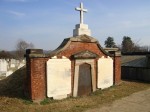 The last burials in the Causten Vault were at the end of the 19th century. After that, the fate of the vault matched the fate of the Congressional Cemetery. It stopped being a fashionable place for Washington politicos and society figures to be buried and gradually fell into neglectful decay. Vaults crumbled, headstones broke, drug dealers and prostitutes plied their trades amidst the historical dead. In 1976 the non-profit Association for the Preservation of the Historic Congressional Cemetery took over management of the cemetery, but it wasn’t until the '90s when volunteers and innovative programs began to boost restoration projects. Its inclusion on the National Trust for Historic Preservation’s list of America’s 11 Most Endangered Historic Places in 1997 brought it fresh attention, including, finally, some maintenance funding from Congress.
The last burials in the Causten Vault were at the end of the 19th century. After that, the fate of the vault matched the fate of the Congressional Cemetery. It stopped being a fashionable place for Washington politicos and society figures to be buried and gradually fell into neglectful decay. Vaults crumbled, headstones broke, drug dealers and prostitutes plied their trades amidst the historical dead. In 1976 the non-profit Association for the Preservation of the Historic Congressional Cemetery took over management of the cemetery, but it wasn’t until the '90s when volunteers and innovative programs began to boost restoration projects. Its inclusion on the National Trust for Historic Preservation’s list of America’s 11 Most Endangered Historic Places in 1997 brought it fresh attention, including, finally, some maintenance funding from Congress.
 Restoration is an ongoing process. The Causten Vault became a priority in 2009 because its mortar was crumbling and the barrel roof was on the verge of collapse. When Douglas Owsley and his team opened the tomb, they found that the interior was in even more dire condition. Over the years the shelves that held coffins had fallen apart, pancaking caskets and human remains in a chaotic pile several feet thick. The remains were carefully removed and transported to Owsley’s lab at the National Museum of Natural History.
Restoration is an ongoing process. The Causten Vault became a priority in 2009 because its mortar was crumbling and the barrel roof was on the verge of collapse. When Douglas Owsley and his team opened the tomb, they found that the interior was in even more dire condition. Over the years the shelves that held coffins had fallen apart, pancaking caskets and human remains in a chaotic pile several feet thick. The remains were carefully removed and transported to Owsley’s lab at the National Museum of Natural History.
Over the past five years, a team of archaeologists and anthropologists analyzed the skeletons taken from the vault, the hardware on the coffins (which helps date the caskets) and personal artifacts found inside. Bones provide all sorts of information, Owsley said, from gender and age to lifestyle (years of heavy labor, for example, take a toll), diet and probable cause of death.
In the final tally, the remains of 16 people were found. The six people known to have been buried in the vault whose remains were not found are thought to have been buried near the bottom of the vault where the damp conditions caused brushite to form on the bones and eventually disintegrate them. The remains of the 16 were identified and placed either in white boxes or in their original cast iron coffins, several of which survived in usable condition. They have all now been reinterred, with their family in attendance, in the Causten Vault.
Another fascinating entry. Thanks, Liv.
I remember being taken on “field trips” to places of historic interest, like churches, that often included cemetaries. I even went through an early-teen passion with the writings on old gravestones and would wander our local Victorian cemetary…wondering about the people.
I got the connection that these were real people who had lived real lives but, until now, I never even thought about that these real people might have real “kinfolk” still walking around at Wal-Mart.
Liv, you have such a way of taking the past and kick-starting it into tomorrow.
Thank you.
Thank you, Sandy. It touches me when historical research can connect people to their bygone family members. It’s a beautiful thing that the living Shrivers can now pay their respects to the past Shrivers, and that we can join them, in a more remote sense, by telling their stories.
At least they know where those remains are. The victims of the Bolshevik revolution vanished, or there corpses were never found, such is the case of His Imperial Highness Grand Duke Mikhail of Russia the youngest brother of Nicholas II, murdered in Perm by the red guards, alongside with his secretary Mr. Johnson, a British subject, or the remains of the three sons of Grand Duke Konstantin Konstantinovich, Igor, John and Konstantin, and their cousin Prince Vladimir Paley, which bodies were buried at the Russian Orthodox Church in Beging, China, during the so-called cultural revolution under Mao the Church was destroyed and nobody knows what the red guards did with those remains, millions of Russians followed the same fate, and their relatives only know that they were murdered.
Well, they didn’t know, is the thing, until the forensic anthropologists started their work and the memory of the Shrivers in the Causten Vault was revived. That’s one of the greatest things archaeology and history can accomplish, in my opinion: give the living a chance to honor their dead.
Sadly, I suspect there are far more people in the world who lost their loved ones through war and conflict and have no burial sites to visit than people who do. From the French Revolution to the Western Front to the Holocaust to the genocide in Rwanda, millions of people have been slaughtered and their remains, if there even are any, scattered who knows where.
Relevance to this blog entry?
Lots of people don’t know where their relatives are buried. One side of my family was in Germany and their resting places were probably bombed to smithereens.
So what? Done is done.
AFAIK, Liv will wax indignant over looting or museums faking provenance to keep stolen artifacts, but I’ve never seen anything to think he feels politics are a useful part of his website.
I certainly don’t.
I actively try to avoid getting into political debates, but as you point out in re looting, sometimes political issues are unavoidable. Thankfully, I think that we can all agree that no matter how people died by whose hand in what conflict, it’s a net good when historians can bring the loss to the light. Not just for surviving family members, either, but for all of us. Attention must be paid, as Death of a Salesman put it.
What this post is to me is a reminder of how cemetaries link us to past generations and are reminders of who we are and where we came from. The first post says that beautifully. I do genealogy, and though I’d not previously been particularly attracted to cemetaries per se, I’ve learned that they carry something important for us in learning about the people we came from, whether genetically or culturally. The little unmarked cemetary down the road is as much a historical and cultural place as that neglected mausoleum, and I suspect that is the real point of this story. We are gradually photographing and documenting gravestones and the records that still survive for these sometimes remote cemetaries, and attempting to locate graves that were recorded but never marked. Living people are becoming reunited with their own past, other members of their contemporary families, and their communities because of this work, and in the process learning something of themselves.
Beautifully put, thank you. :thanks:
I’m interested in what the Baron has to say, Sandy, and find your comments a bit insensitive. All of us have relatives whose resting places are unknown, but that doesn’t invalidate the feelings of those who wish they did know.
Let’s let Livius decide who has crossed the line in the comments section.
I think the line is safe from encroachment at this point. We all agree that having a locus for mourning and knowing that your ancestors’ remains are being treated with respect is extremely important to our shared human experience. The question of proper burial looms massively large over history.
That.
:yes: :yes: :yes:
Annie, you’ve put my own thoughts down so very well. I think that the more we can see others as links in a chain of humanity that spans eons, the more we realize just how important the past can be.
Thank you.
I meant no offense. However, I’m getting a tad tired of running into politics in the most unlikely places on the Inet.
I am not angry at my countrymen, including my own father, who blasted MY ancestors into smithereens. Except for two photographs, I have nothing. I’d prefer it didn’t happen, but done is done and can’t be changed. I’m certainly not going to launch a diatribe against what happened.
I just enjoy a place where people’s ideas of “who done me wrong” are limited to looters and museums.
It’s such a refreshing change.
It’s intriguing to see the child-sized cast iron coffin. I’ve seen only the iron coffins with a glass viewing window, but those are Civil War period and probably later.
I followed the bread crumb trail to the Post article and enjoyed reading about Doug Owsley’s prior use of Dr. Carlos Carvallo’s medical records. Carvallo’s background must be interesting. Sounds as if he’d be a good paper topic for someone.
Owsley is a fellow University of Wyoming graduate.
My dear late-friend Robert White took me to The Congressional Cemetery back in the early 1990s. Even during daylight hours, it was a dangerous place; being hungry for history, we braved the risk and stayed for almost the entire day.
The place was amazing, beautiful and terribly forlorn. Each time we came upon an important name, we would discuss the history and stand amazed at how abused the graves were at the site.
The last visit my family made there, the place was teeming with visitors – it was park-like and was finally getting the respect it deserved.
I am pleased this vault – like that of Att. Gen. Wm Wirt has received attention and restoration.
I’d like to thank the person who wrote this article.
These are my relatives as well. I can draw a straight line from me to his daughter Josephine (I am the fifth Josephine in our lineage)We grew up with James Causten (and his wife, Eliza’s) portraits on our living room wall. Many family and historical artifacts, letters, photographs, etc. have been carefully preserved and passed through the generations and are still in the family today. These people were spoken of under the roof of our home and the stories are fascinating!
The Causten family tree includes, Manuel Carvallo and Mc Clintock Young and they lived such interesting lives too. I am amazed at the brilliance of Josephhine Causten who donated the “Causten Family Letters” to the Georgetown University so we can have such a clear window into American history!
Living in Northern California, I didn’t know the situation with the family vault and found your article most interesting!I also didn’t know that Henrietta had named a child Josephine too!
Thank you again for writing this blog and keeping our family history current.
Thank you so much for commenting. What a wonderful thing to be a Josephine in a long line of illustrious Josephines, and I’m grateful your family has been so conscientious about preserving their history. I hope you have a chance to head out east to see your beautifully restored family vault.
James Causten was outlived b his Daughter Alice Causten Fisher whom was married to Gen Benjamin Franklin Fisher. She was later disinherited by her father for reasons I am not sure of. Alice Causten is my Great-Great Grandmother. I have researched my family history so I knew about the Causten family tomb and the Dolley Madison connection, but was very pleased to read that Doug Owsley had restored the vault and saved a piece of history. My mother Alice Fisher Moerder used to tell me about family reunions that included her cousin Sargent Shriver as a child that were held at the Old Hains Church in Phoenixville PA.